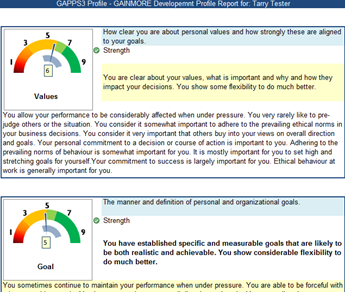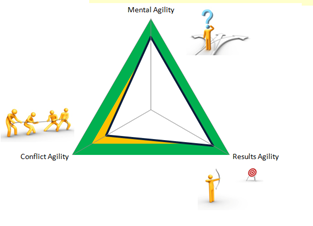GAINMORE™ Advantage Potential to Performance System Version 3
Welcome to GAPPS3!
Our GAPPS3 Assessment is unlike other psychometric tests that you may have used in the past. Such tools are most often used to determine the individual’s ‘personality’ or ‘traits’ which you then most often use to determine what sort of person you are
Other assessments that you may have taken compare your behaviours or characteristics against those of the organization, or the team, or a few, the job. This is great… but… they do not tell you what you really need to know after this.
Can you be developed? If you can, what do you need to develop to achieve what you want to achieve? And what are your development priorities? Do you have the potential to succeed? Is this position and company (and its values) right for you? Do you show integrity? And many other unanswered questions… until now.
Everyone who uses GAPPS3 receives a copy of their full report and personal feedback from a professional coach. Together, we identify the high priority development areas and necessary mindset to raise performance to reach your potential.
GAPPS3 is used by leading organizations both large and small. Through all stages of the employee life-cycle: recruitment and selection, on-boarding, performance management, succession planning, talent management, transition and even out-placement.
The GAPPS3 Assessment
GAPPS3 is our powerful GAINMORE™ Advantage Potential to Performance System. Unlike other leadership assessments, GAPPS3 provides you with a comprehensive profile report showing your AAA for leadership success:
- Leadership Attributes
- Leadership Abilities
- Leadership Agility
GAPPS3 identifies your current strengths AND your priority development areas AND your potential as a leader. With links to our unique, interactive online learning system. The GAPPS3 full assessment includes personal feedback coaching (45-60 minutes) preferably face to face, else by video conference. You can also receive access to the GAINMORE™ Leadership Advantage Toolbox – this covers the foundational modules for each of the 12 areas under the GAINMORE™ model as a full, interactive and supported online learning tool.
Your GAPPS3 profile report is sent to you in pdf format one working day before your scheduled feedback coaching session.
Feedback Coaching
Everyone who takes our GAPPS3 assessment schedules their feedback coaching with one of our professional coaches. This session, if you are in Singapore or near our international offices in New Zealand, Sydney Australia, or London UK is best conducted face to face at your offices. When it is not convenient to meet in person, feedback coaching is done by web video conference or for those of you without the infrastructure, by telephone.
Your feedback coaching session lasts for 45 minutes to one hour. It is your chance to ask questions, clarify anything about your profile and to benefit from guidance by a professional, experienced leadership development expert. It is your time, make the most of it. Often, your coach will give you “homework” – specific guidance to do something. This might be to access our Leadership Advantage Toolbox (which is also included). Perhaps we recommend a particular book to read, video to watch, or simply complete a template about your own goals.
After your Feedback
Your coach will send a summary report of your feedback coaching session to you via email. This serves as a reminder of your discussions and usually includes any links to recommended resources for your continued development.
Is it confidential?
All our coaches operate under the guiding principles of the International Coaching Federation and the UK Data Protection Act.
Your coach will NEVER share personal information that has no direct relationship or relevance on your sponsoring organization with any other person.
If your GAPPS3 assessment is sponsored, after your feedback coaching session we share with your sponsor (usually your HR and/or direct line manager):
- A summary GAPPS3 assessment profile.
- A summary of your post feedback coaching session report AFTER you have received this report and not indicated to your coach to edit within 48 hours of receipt by you.
In short, we will only share information about you that has direct relevance to your development in your work or performance. All information shared is subject to your agreement with your coach that it may be shared.
How does it work?
- Your sponsor (usually led by HR) informs us that you are to take the GAPPS3 assessment.
- We send you an email inviting you to participate. This email includes your unique coded link to take the assessment.
-
The assessment itself takes between 25 and 40 minutes to complete.
- Answer all questions and statements honestly and candidly. This assessment is for your benefit. It is for you to learn what your leadership strengths are, and the development areas to achieve what you want to achieve.
- There are no right or wrong answers.
- Answer all questions and statements honestly and candidly. This assessment is for your benefit. It is for you to learn what your leadership strengths are, and the development areas to achieve what you want to achieve.
- When you submit at the end of the assessment you will see a ‘Successful Submission” screen and later receive an email confirming your successful submission.
- On the “Successful Submission” screen you will be prompted to schedule your feedback coaching session. Click the link and login to our coaching calendar, please indicate where the coaching will take place (office address, room, or skype name or telephone number).
- Choose a day and time available on our calendar. You will receive an email confirmation with an ical attachment (sycn this straight into your own calendar). Please try and schedule your session within one week of submission.
-
24 hours prior to your scheduled session, you will receive an email reminder with a link to download your GAPPS3 profile report pdf copy.
- Please consider the environment before printing, your report is 18 pages in colour. You may bring your laptop to the feedback coaching session.
- Please consider the environment before printing, your report is 18 pages in colour. You may bring your laptop to the feedback coaching session.
- Your feedback coaching session will last 45 minutes to one hour.
- After your session, your coach will send an email summary report as a reminder of your feedback and any links to help your continued development. Usually within 24 hours.
- 48 hours after your session, your coach will send you an email with a link to confirm that you have received your feedback summary report and asking for your agreement to share your report with your sponsor.
- Within 7 days of your feedback session, your coach will share agreed information with your sponsor.
-
Typically within 3 weeks, your coach will follow up with you to:
- Check your progress with your “homework”
- Evaluate the GAPPS3 assessment and feedback coaching
- Check your progress with your “homework”
What is GAPPS3?
GAPPS3 identifies your current strengths AND your priority development areas AND your potential as a leader. With links to our unique, interactive online learning system. The GAPPS3 full assessment includes personal feedback coaching (45-60 minutes) preferably face to face, else by video conference. You can also receive access to the GAINMORE™ Leadership Advantage Toolbox – this covers the foundational modules for each of the 12 areas under the GAINMORE™ model as a full, interactive and supported online learning tool. Additional comparative profiles for teams, culture fit, recruitment and all parts of the employee life cycle are available to accelerate and improve your interventions.
Your profile report includes an overview and comparison with your chosen benchmark.
Leadership Attributes and Abilities: GAINMORE™ Development profile, and IQ, MQ & EQ.
GAINMORE™ Attributes and Development Report

You can choose from:
|
Detail example Leadership Attributes
Showing each Attribute and Ability clearly, the individual’s ‘normal’ behaviour and the Agility they demonstrate in each factor. |
|
Your Team Leadership Role preferences and behaviour: |
And, uniquely, your potentiality index! |

You may be looking for someone to fit the current team, or re-balance the team and sometimes, create change in the team culture! |

Looking to recruit someone who is going places? Or perhaps someone who is likely to settle at the level you are recruiting? |
The primary use of GAPPS3 is for leadership development and coaching. You can use it to undertake a 360˚ assessment of your leadership team, succession planning, high potentials identification… You get the idea.
Arrange a meeting with us to discuss how we can partner with you now.
Call us at +65 62450908 or email gapps@celsim.com







